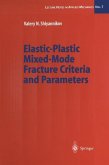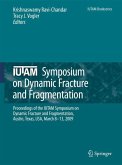' The book is recommended for engineers and research workers interested in modern mechanics of materials...In addition, there is a very rich and up-to-date collection of references that is very useful for readers wishing to improve their knowledge of any specific topic in fracture mechanics.' -- Meccanica 27:143-145 1992
It is difficult to do justice to fracture mechanics in a textbook, for the subject encompasses so many disciplines. A general survey of the field would serve no purpose other than give a collection of references. The present book by Professor E. E. Gdoutos is refreshing because it does not fall into the esoteric tradition of outlining equations and results. Basic ideas and underlying principles are clearly explained as to how they are used in application. The presentations are concise and each topic can be understood by advanced undergraduates in material science and continuum mechanics. The book is highly recommended not only as a text in fracture mechanics but also as a reference to those interested in the general aspects of failure analysis. In addition to providing an in-depth review of the analytical methods for evaluating the fundamental quantities used in linear elastic fracture mechanics, various criteria are discussed re:O. ecting their limitations and applications. Par ticular emphases are given to predicting crack initiation, subcritical growth and the onset of rapid fracture from a single criterion. Those models in which it is assumed that the crack extends from tip to tip rely on the specific surface energy concept. The differences in the global and energy states before and after crack extension were associated with the energy required to create a unit area of crack surface. Applications were limited by the requirement of self-similar crack growth.
It is difficult to do justice to fracture mechanics in a textbook, for the subject encompasses so many disciplines. A general survey of the field would serve no purpose other than give a collection of references. The present book by Professor E. E. Gdoutos is refreshing because it does not fall into the esoteric tradition of outlining equations and results. Basic ideas and underlying principles are clearly explained as to how they are used in application. The presentations are concise and each topic can be understood by advanced undergraduates in material science and continuum mechanics. The book is highly recommended not only as a text in fracture mechanics but also as a reference to those interested in the general aspects of failure analysis. In addition to providing an in-depth review of the analytical methods for evaluating the fundamental quantities used in linear elastic fracture mechanics, various criteria are discussed re:O. ecting their limitations and applications. Par ticular emphases are given to predicting crack initiation, subcritical growth and the onset of rapid fracture from a single criterion. Those models in which it is assumed that the crack extends from tip to tip rely on the specific surface energy concept. The differences in the global and energy states before and after crack extension were associated with the energy required to create a unit area of crack surface. Applications were limited by the requirement of self-similar crack growth.
' The book is recommended for engineers and research workers interested in modern mechanics of materials...In addition, there is a very rich and up-to-date collection of references that is very useful for readers wishing to improve their knowledge of any specific topic in fracture mechanics.' Meccanica 27:143-145 1992
' The book is recommended for engineers and research workers interested in modern mechanics of materials...In addition, there is a very rich and up-to-date collection of references that is very useful for readers wishing to improve their knowledge of any specific topic in fracture mechanics.' Meccanica 27:143-145 1992








